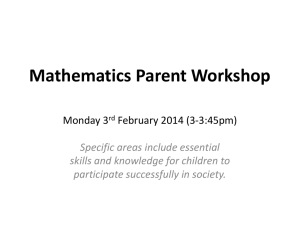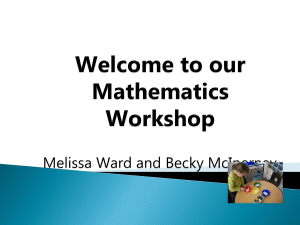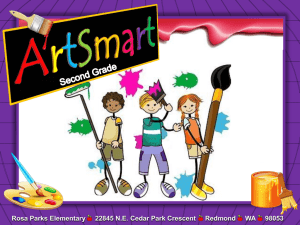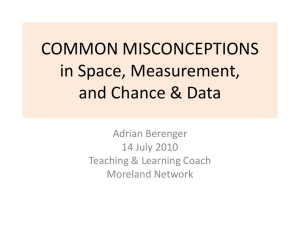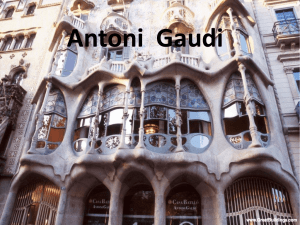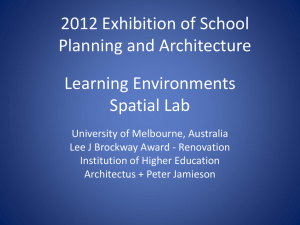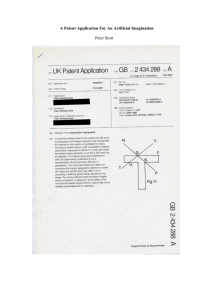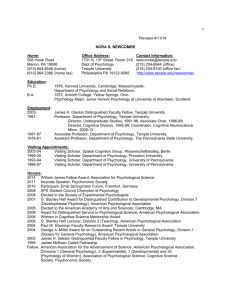Public Lesson Guide - OISE
advertisement
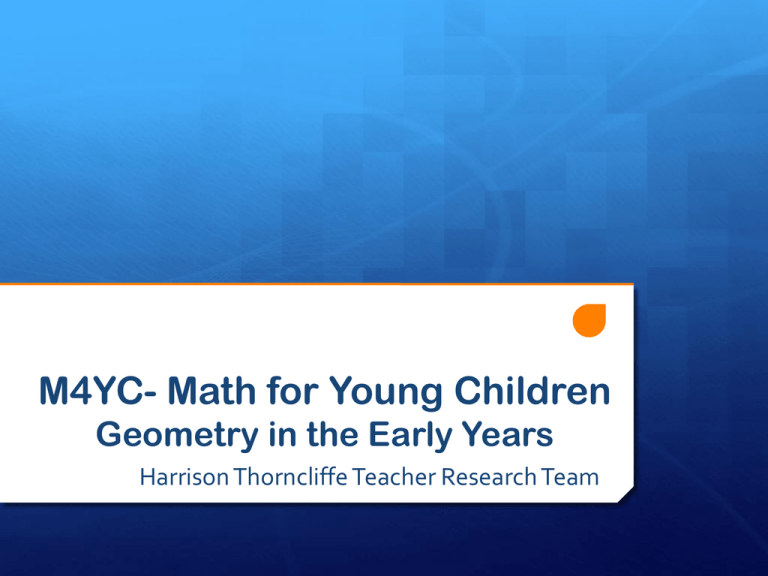
M4YC- Math for Young Children Geometry in the Early Years Harrison Thorncliffe Teacher Research Team Acknowledgements Literacy and Numeracy Secretariat, Ontario Ministry of Education Toronto District School Board (TDSB) Dr. Joan Moss (University of Toronto) and Dr. Cathy Bruce (Trent University) The Thorncliffe Harrison team with special thanks to the teachers and early childhood educators, principals and vice principals, instructional leaders, and math coaches. Dr. Eric Jackman Institute of Child Study N.S. Robertson Program for Inquiry-Based Teaching in Mathematics and Science ICS MA graduate students: Shona Douthwaite, Sarah Naqvi, Jamie Morris, Melanie Mancini, Emily Mackenzie Discussants: Diane Tepylo and Carol Stephenson What is lesson study? A collaborative professional development process, originating in Japan in which teachers jointly plan, observe, analyze and refine actual classroom lessons called “research lessons.” Lesson Study: • is doing research, not just reading it • is done by teachers, not done to teachers • is based on collaboration, not on hierarchy Why Geometry? Research indicates that early attention to developing children’s spatial thinking increases their achievement in math and science and can promote skill and interest in future careers in the STEM disciplines (Science, Technology, Engineering, Mathematics) (Newcombe, 2010) Can be substantial improvements in spatial skills from a wide variety of interventions and these improvements were durable and transferrable to other tasks and settings (Newcombe,2010) Spatial sense comes into play in: art, science, social studies, movement, music and reading (Copley, 2000). Development of spatial reasoning will help children to make sense of their spatial world and also other mathematical concepts (Copley, 2000). Gaps in the Research Literature Little research has been done to show specific activities that teachers can use to improve students’ spatial reasoning and spatial visualization. Literature Review: What we learned from the research Visualization, Spatial Reasoning, and Modelling are important in other areas of mathematics. Important skills include: Imagining what an object looks like from a different point of view (e.g., from above rather than from the side). Predicting what an object will look like after it is turned or flipped Relating 2D renderings to the 3D objects they represent Creating mental images of 2D and 3D objects Visual memory – the ability to recall what has been changed about a shape, figure, or arrangement - is a prerequisite to the ability to manipulate mental images. Number Knowledge Test A test that is designed to measure the intuitive knowledge of numbers that an average child has available at the age levels of 4, 6, 8, and 10 years. Administered by graduate students and researchers from the Dr. Eric Jackman Institute of Child Study, University of Toronto Clinical Interviews: Developmental Levels for Composing Geometric Shapes Children move through levels in the composition and decomposition of two-dimensional figures. Very young children cannot compose shapes but then gain the ability to combine shapes into pictures, synthesize combinations of shapes into new shapes and eventually build new shapes. Children typically follow an observable developmental progression in learning about shapes. This developmental path is often described as part of a learning trajectory. Clinical Interviews: 2-D Tasks Kindergarten: Task #1: - Students were shown a picture and ask what it resembled and then had to fill in the outline of the picture using the pattern blocks. Task #2: Reforming a Square- Students are shown a square and watch it being cut in 2 pieces, reform back into a square then with 3 and 4 pieces. Task #3: Students are shown a picture for 5 seconds and then they are asked to recreate the picture. Pattern Block Activity Students were shown a picture and asked what they thought it resembled. Students then had to fill in the outline picture using the pattern blocks. Show video: The student you will see in this video clip engaged in self-talk and the use of gestures while trying to figure out where the shapes should be placed. Pattern Block Activity Students were shown a picture and asked what they thought it resembled. Students then had to fill in the outline picture using the pattern blocks. Show video: The student you will see in this video clip engaged in self-talk and the use of gestures while trying to figure out where the shapes should be placed. Results of the Clinical Interviews Children were highly motivated to participate in the tasks at all levels (low, medium and high performing students) Pattern blocks: Some frustrations once the initial larger shapes were in place but students continued to work on filling in the picture Some students tried to fill in the pictures using symmetry (same shapes on each side) A lot of student talk when they were working on the pattern blocks Square task: Difficulty once the students moved to 3 or 4 pieces but continued to try even when experiencing difficulty What we learned from clinical interviews Students were highly motivated to participate in the task. Most students identified the outline pictures as a cat or dog and a rocket. Some students were especially meticulous and precise in which shapes they chose and how the placed the shapes inside the outline picture. Although some students faced difficulties, most students were persistent as they attempted to fill in the whole picture. Students engaged in self-talk and the use of gestures while trying to figure out where the shapes should be placed. Overall we found many students used mathematical language Supporting Student Learning in Geometry with Technology i-Pads and Apps Technology can allow children to carry out the mental morphing that is going on in their head (ie mirror images, morphing of images) (Olive, 2000) The dynamic transformation of technology is enabling and thought-provoking to the students New understandings: What the children learned Shape: ability to analyze characteristics and properites of 2D and 3D objects and develop mathematical arguments about geometric relationships Location: ability to specify positions and describe spatial relationships using various representational systems Transformations: exploring motions of slides, flips, and turns; altering objects’ location or orientation but not its size or shape).Shapes can be moved without being changed. Visualization: ability to create and manipulate mental images and apply spatial reasoning and geometric modelling to solve problems. Gestures in Learning Newcombe, 2010: When teachers use gesture in instruction, children often learn better than when taught using speech alone. When children gesture as they explain the problem they learn better than if they do not gesture. Susan Goldin-Meadow: Gestures can reveal information that was not verbalized about how students solve problems. The student’s use of a gesture may indicate that they are explaining or using knowledge that they did not know they had - this may be at the level in which they are challenged by the task and can benefit from instruction References Copley, J. V. (2000). Geometry and Spatial Sense in the Early Childhood Curriculum. The Young Child and Mathematics. Washington DC: National Association for the Education of Young Children. Reston, VA: National Council of Teacher of Mathematics. Goldin-Meadow, S. (2004). Gesture’s Role in the Learning Process. Theory into Practice, 43 (4). p. 314-321 Newcombe, N. S. (2010). Increasing Math and Science Learning by Improving Spatial Thinking. American Educator, Sumer 2010 Olive, J. (2000). Implications of Using Dynamic Geometry Technology for Teaching and Learning. Paper for Conference on Teaching and Learning Problems in Geometry. Fundão, Portugal, May 6-9, 2000.


